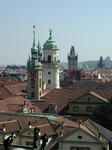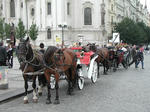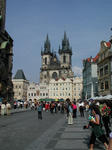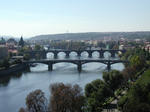Prague, the capital city of the Czech Republic, is presently undergoing a period of great changes after having once again become a free metropolis of Central Europe. This magical city of two million inhabitants is situated on both banks of the Vltava River, which flows northward through the heart of town.
Prague, like Rome, was constructed upon five hills and is shrouded in the mystery of a glorious, tragic past. Since medieval times it has been known as one of the most beautiful cities in the world.
The history of Prague has been intertwined with that of Europe for eleven centuries. Despite its cosmopolitan character, which can be seen in the broad range of architectural styles, the city has maintained its purely Czech nature.
By the 14
th century, Prague had already become a metropolis, surpassing many other Central European cities in grandeur.
Presently, major renovations and renewal projects are preparing the city for the 21
st century. Due to its beauty and vitality, Prague has become a magnet for millions of tourists from all over the world, a new home for many, and a prosperous center of enterprise.
A walk through Prague is like reliving the history of Europe, as well as the evolution of culture brought about by various reformers, artists, rulers, and politicians.
The original
town was built on both banks of the Vltava River in a valley between two castles. One of them, the Vysehrad Castle, royal seat only to the Czech King Vratislav, was situated in the southern portion of the city. Today, the Church of Saints Peter and Paul stands upon this site, as well as Slavin cemetery, burial place of many great men and famous personalities.
Construction of Prague Castle was begun in the 9
th century, and it has been home to heads of state from the middle ages until the present.
Prague, aside from Rome, has been the only European capital city to remain for the past eleven hundred years the undisputed seat of power in its state. In Prague Castle's St. Vitus Cathedral lies the tomb of King Wenceslas, patron saint of the Czech lands of Bohemia, Moravia, and Silesia.
The centerpiece of the Old Town, located on the eastern bank of the Vltava, is
the Old Town Square and original Old Town Hall, which boasts the famous Prague
astronomical clock. Across the square stands the monumental

Church of Our Lady of Tyn. From the Old Town Square wind numerous narrow streets and alleys full of remarkable sights, including churches, cathedrals, galleries and museums, antique shops, and centuries-old wine and beer cellars.
An important part of the Old Town is the Jewish Town, or
Prague Ghetto, as it has been called since the 16
th century. Its origins date back to the 9
th century, when it began as a colony of Jewish merchants who permanently settled in Prague. In the 17
th century it became Central Europe's Hebrew metropolis.
The ghetto's most impressive buildings and historical monuments still remain to this day. The Jewish Town has one of the oldest synagogues in Europe, dating from the 13
th century. The Jewish Town Hall, with its original Hebrew clock, also features a museum with the world's largest collection of unique Jewish relics, portions of manuscripts, Talmuds, Torah scrolls, a collection of silver candlesticks, temple curtains, and a library of Hebrew and Judaic literature.
The Old Jewish Cemetery, with more than 200,000 graves, houses the remains of many of the most significant members of Prague's former Jewish community. Nearby stands the
Charles Bridge, Prague's oldest stone bridge. Built by Petr Parler of Gmund over six hundred years ago on the order of King Charles IV., it leads to Mala Strana. This quarter is probably the most romantic in Prague, with its beautiful architecture and many gardens. Further along from the bridge lies Malostranske Square, followed by Nerudova Street and the Castle Stairs, which lead to the gates of Prague Castle. From here, all of Prague and its countless beautiful spires lie spread out at your feet.



 Guide
Guide 





